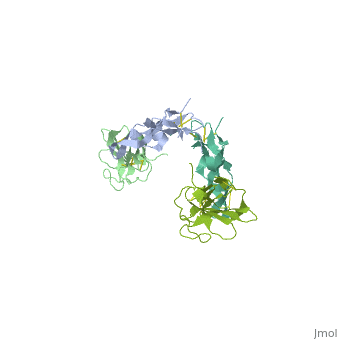TGF beta signaling pathway
From Proteopedia
(Difference between revisions)
| Line 1: | Line 1: | ||
<StructureSection load='1ktz' size='340' side='right' caption='Human hTGFR-II extracellular domain (green) complex with TGF-β3 (grey) (PDB code [[1ktz]])' scene=''> | <StructureSection load='1ktz' size='340' side='right' caption='Human hTGFR-II extracellular domain (green) complex with TGF-β3 (grey) (PDB code [[1ktz]])' scene=''> | ||
==[[TGF-beta receptor]]== | ==[[TGF-beta receptor]]== | ||
| - | '''TGF-β receptors''' (Transforming Growth Factor) (TGFR) are serine/threonine kinase receptors. They are involved in paracrine signaling and are found in many types of tissue. TGF-β ligands include bone morphogenetic proteins, growth and initiation factors, anti-Mullerian hormone, activin, nodal TGF-β<ref>PMID:9525694</ref>. | + | '''TGF-β receptors''' (Transforming Growth Factor) (TGFR) are serine/threonine kinase receptors. They are involved in paracrine signaling and are found in many types of tissue. TGF-β ligands include bone morphogenetic proteins, growth and initiation factors, anti-Mullerian hormone, activin, nodal TGF-β<ref>PMID:9525694</ref>. There are 3 types of TGFR: <br /> |
| + | *'''TGFR I''' forms heteromeric complex with TGFR II when it is bound to TGF-β. The complex transduces the TGF-β signal from the cell surface to the cytoplasm by phosphorylating proteins which regulate the transcription of genes related to cell proliferation. TGFR I has high affinity for TGF-β1 and low affinity for TGF-β2. <br /> | ||
| + | *'''TGFR II''' is a tumor suppressor transmembrane protein. TGFR II has high affinity for TGF-β1 and low affinity for TGF-β2. <br /> | ||
| + | *'''TGFR III''' is a cell-surface chondroitin sulfate / heparin sulfate proteoglycan. It acts as a reservoir of ligand for TGFRs. TGFR III has high affinity for TGF-β1, TGF-β2 and TGF-β1.2. | ||
</StructureSection> | </StructureSection> | ||
== References == | == References == | ||
<references/> | <references/> | ||
Revision as of 14:29, 16 February 2022
| |||||||||||

